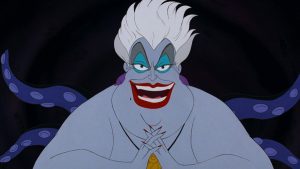With Frozen 2 – Disney’s first theatrically released Disney Princess sequel (which is a lie, but we’ll get to that in a moment) – on the horizon, it seems fitting to me that somebody should take the time to go through each and every one of those Princess movies, to see which ones have withstood the test of time, and which belong somewhere in the depths of the impenetrable Disney vault. There are a few qualifiers that I think make a good Disney Princess movie – a spectacular soundtrack of great Songs; a dastardly Villain hell-bent on stirring up chaos; and, of course, a powerful Princess who takes matters into her own hands and establishes a place for herself in the world. Since quite a lot of the Disney Princesses have corresponding Princes, I’m also adding them to the categories, but the studio’s two most recent Princesses have all been single ladies, so we’ll take a moment to admire that when we get up to them. We’re going through each of the twelve movies in chronological order, so it’ll take us a while to get from Snow White’s magical Germanic forests to the sunny shores of Moana’s Polynesian island community.
(Also, I’m only ranking the Princesses officially honored as such by Disney: which means that neither Meg from Hercules nor Esmeralda from The Hunchback Of Notre Dame will be be showing up on this list. Oh yeah, and there are two other women who are notably absent, despite the fact that this post is inspired by the imminent release of their sequel movie – that’s right, Anna and Elsa aren’t official Disney Princesses, apparently: I didn’t know that when I started writing this post, but by the time I found out it was too late to scrap the idea, so that’s how I ended up in this situation).
(Oh, and by the way: SPOILERS AHEAD, for any and all Disney movies referenced below).
Snow White And The Seven Dwarfs (1937):
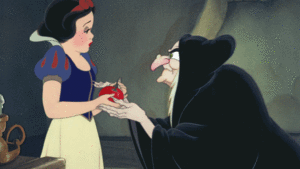
The Princess: I have no qualms about saying this – if any Princess deserves to be bumped from the list, it’s Snow White. A quaint, outdated character without any agency in her own story, the fairest maiden in the land is constantly running from danger or welcoming it into her house – even though, with an army of magical birds and beasts, and a fiercely devoted bodyguard of seven heavily-armed men, Snow White could technically have stormed the Wicked Queen’s castle without any problems. I mean, let’s face it – the Wicked Queen’s own forces consisted of, what, a single crow and a huntsman who couldn’t even follow orders? When you think about it, Snow White had a lot working in her favor, but squandered her chance. Instead, she spends most of the movie fretting about the dwarfs’ hygiene or washing clothes. Ranking: 2/10
The Prince: with some of the early Disney Princes, the best you can say about them is that “they’re there”. With Snow White’s Prince Charming, even that would be a lie – the dude only shows up in the first and last ten minutes of the movie, and all he does is sing. Where exactly was he when his dearly beloved Snow White was hiding in the forest with seven little old men? Where was he when the Wicked Queen needed killing? This guy is the absolute worst, and Snow White could have done much better. Ranking: 1/10
The Villain: Snow White isn’t a total disaster. The Wicked Queen (fun fact: her real name is Grimhilde) is a very compelling villain with an appetite for evil and a great sense of style. Intent on being the most beautiful woman in all the land, the Queen is horrified to learn that poor little Snow White, her stepdaughter, is in fact more lovely than she. But instead of just stabbing her in her sleep or tossing her down that wishing well in the courtyard, the Queen instead relies on a third party to do her dirty work – she’s the first Disney villain to learn the hard way that evil henchmen are almost inevitably never as evil as advertised. Then again, the Queen herself does eventually get killed by an unlucky bolt of lightning, so maybe she just wasn’t that competent to begin with. Either way, her death scene provides for one of the film’s most haunting visuals, when a pair of vultures which had shadowed her footsteps hoping to feast on Snow White’s dead body instead end up eating the Queen herself. Lovely. Ranking: 4/10
The Songs: If I could give the songs in this movie a 0 rating, I would. There are only a handful of tunes in Snow White that actually have lyrics, and they are all interminably alike in their chipper, tra-la-la-lally sweetness. They are also incredibly hard to listen to, as Snow White tends to sing or whistle (or, god forbid, hum) in a high-pitched register only audible to dogs. The dwarfs sing “Hi Ho” at every available opportunity. The Prince sings one song twice – no, literally, he sings “One Song”, but he does so twice, to bookend the movie. Both times it’s an ear-splitting nightmare. Rating: 1/10
Happy Ever After? in the end, Snow White is poisoned by the Wicked Queen and sent into an everlasting slumber that lasts all of five minutes before she is woken by the Prince’s “singing” – to be polite, she had to pretend it was true love’s kiss that woke her, but I think we all know better. The Prince barely even gives her a chance to say goodbye to her friends in the forest before riding off with her into the sunset. It’s an abrupt and undeserved ending. Snow White is a landmark in animation history, and, frankly, in cinematic history. That’s something I respect and admire – but from a safe distance. Up close, from its casual misogyny to its tediously long house-cleaning sequences, this movie is a Sleeping Death all in itself.
Cinderella (1950):
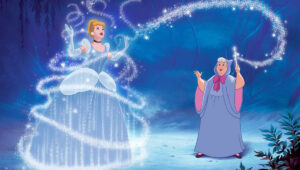
The Princess: she may not seem like much on the surface, but Cinderella is a huge improvement from Snow White. She makes decisions on her own, she takes action when she needs to, and she doesn’t simply fall in love with the Prince because he’s a Prince. In fact, something that is often overlooked about this movie is that Cinderella never even considered the Prince – she just wanted to get out of the stuffy old chateau and attend the royal ball, and she was justifiably angry at Lady Tremaine for keeping her housebound. Considering that the villain Maleficent’s entire motivation in Sleeping Beauty was getting revenge on the royalty for not inviting her to a party, I don’t think that Cinderella was wrong for feeling slighted. Granted, it would have been nice to see her embrace her inner dark side, don a pair of horns, and wreak havoc on the land, but hey, to each their own? Rating: 4/10
The Prince: nameless and mostly voiceless, Cinderella’s prince doesn’t even get to sing one song, or any song at all, before he’s out of the picture entirely. For whatever reason, he’s not even the guy who has to go around the kingdom trying shoes on feet to see which woman is his one true love. But at the same time, he still breaks Disney tradition: until Cinderella dances into his life, the Prince is bored out of his mind by the very idea of romance, and has no intention of getting married. Rating: 2/10
The Villain: Lady Tremaine, Cinderella’s abusive, cold, calculating stepmother, is a Disney icon – though most people simply know her as the Wicked Stepmother. And wicked she is, for every action she takes in the film is either intentionally devised to suppress Cinderella’s own freedom, or does so accidentally anyway. Residing in a spacious bed beneath the inky shadows of a vast purple canopy with only her demon cat Lucifer to keep her company, Lady Tremaine is definitely #VillainGoals. And she’s cunning, almost immediately realizing that Cinderella was the Prince’s mystery date at the ball, and taking action at once to ensure that Cinderella never escapes. Rating: 4/10
The Songs: meh. Okay, so there’s “Sing, Sweet Nightingale” and what else exactly? The music in Cinderella is utterly forgettable. Regardless, it’s still a step up from Snow White. Rating: 3/10
Happy Ever After? while it’s still a low-stakes love story, Cinderella does represent a progression, no matter how small. The female protagonist actually has some agency in her story; she has personality and characteristics; and she defies the villain instead of running and hiding. It’s the first Disney Princess movie to pass the Bechdel test (and it also fails the reverse Bechdel test – i.e. no two male named characters talk about anything other than a woman), and all of its female characters, even down to the Wicked Stepsisters, have their own arcs. Cinderella is often painted as another of Disney’s antiquated damsels in distress, but she is, in fact, their first heroine, though on a very small scale (it’s worth mentioning that she does, in fact, become a damsel in distress at the very end of the movie, but is saved, not by a man, but by her animal friends). For more on the feminism of Cinderella, see here. And let’s not forget that everything Snow White and Sleeping Beauty did, Cinderella did in glass high heels. Beat that, Aurora.
Sleeping Beauty (1959):
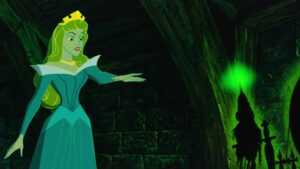
The Princess: after the high point that was Cinderella, one would expect Disney to keep making progress, to keep forging ahead, to deliver up great Princess content for years to come. But instead, Aurora was the only Princess to come out of the studio between Cinderella‘s release in 1950 and The Little Mermaid in 1989. And Aurora isn’t what one would call a feminist icon of any kind: yes, she marries for love, and the film makes a point of establishing that she has no idea she’s falling for the man who just so happens to have been betrothed to her at birth (funny how that worked out, right?), but she also has no agency. If she were the only female character in the film, it would be a huge problem: as it is, she’s still technically the protagonist so it is still a huge problem, but thankfully there are three other female leads who basically take over the entire movie while Aurora is asleep. But the Princess herself: well, she’s not exactly role model material. Rating: 3/10
The Prince: even while Aurora is falling in love with Phillip (who just so happens to be a prince, even though he never mentions it to her), Phillip himself is falling in love with Aurora (who he thinks is a peasant girl, but of course is secretly a princess). And so Disney attempts to have their cake and eat it too: see, they married for love! But they’re both still royalty, because of course they are. It’s mixed messaging, to say the least. Phillip himself is a boring, one-dimensional character like all the early Disney princes, and he doesn’t really do anything besides wake Aurora with “true love’s kiss”, a.k.a. kissing her without consent. Rating: 3/10
The Villain: Maleficent, Mistress of Evil (not to be confused with Maleficent: Mistress Of Evil), is a hellish character with a lot of attitude, who does actually get stuff done, as opposed to her predecessors. Upon learning that she wasn’t invited to the christening of baby Aurora, Maleficent abandons whatever she was doing up until then and devotes her entire life to finding the baby and killing it. And she comes close, sending Aurora into an eternal slumber that lasts about twenty minutes, until her plans are undone by the magic of the Good Fairies. She’s a demonic force of chaos and unbalance that, honestly, is a lot of fun to watch. Rating: 5/10
The Songs: “Once Upon A Dream” is simply not an interesting song in any regard. Rating: 1/10
Happy Ever After? like all of Disney’s classic Princess films, Sleeping Beauty is tainted with sexism of all kinds: the non-consensual kiss; the arranged marriage (which is set up when Aurora is barely a day old, and Phillip is already, like, ten) at the movie’s core; and of course the three “essential” gifts that the Good Fairies give to Aurora – beauty, song, and…um, the ability to be awoken from a sleeping spell on her sixteenth birthday by her one true love, on the off-chance that something like that should ever happen. You know, just in case. On the other hand, even though Aurora is pretty much a non-entity, her guardians, the three Good Fairies, are all fully fleshed-out female characters with a lot of attitude and determination. Not only do these fairies not conform to traditional gender norms (their attempts to bake a birthday cake and sew a party dress for Aurora go…very badly), they also enter Maleficent’s castle on their own and save Prince Phillip, before basically becoming Athena-esque muses of battle, giving Phillip the magical weapons he needs to defeat Maleficent. Now, there are problems with this scenario: the three Good Fairies are so awesome, they could probably have fought Maleficent on their own without any help from a pesky mortal prince, and somehow they just decide that Phillip is Aurora’s “one true love” without ever consulting her beforehand – I know, I know, it would have been a little difficult, considering she was asleep, but come on: if Phillip’s kiss had failed to do the trick, would the Good Fairies have just rounded up all the men in the world and had them try to kiss Aurora back to life? In the live-action retelling, Maleficent, it is a mother’s kiss that awakens the sleeping princess – the three Good Fairies, who had basically been Aurora’s mothers for sixteen years, should surely have considered that “true love” doesn’t have to be romantic love, right? Apparently not.
The Little Mermaid (1989):
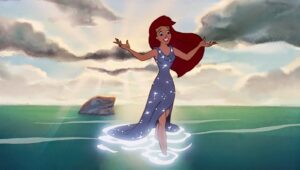
The Princess: Ariel deserves a lot of credit for being Disney’s first really proactive princess protagonist: as opposed to Cinderella and Aurora, who both get landed with magical godmothers they didn’t even ask for, Ariel actually goes looking for one, and finds one – who promptly manipulates her, uses her as a power-play in her war against the Sea-King, steals her voice, and then tries to run off with her boyfriend of two days. Yes, Ariel is the heroine of her own story, and she does make some very important decisions that shape the whole plot – but her willingness to make such decisions is almost always presented as a fault: instead of relying on the “wise” counsel of the men and male fish/crabs/seagulls, etc in her life, she commits the biggest crime that an outdated Disney princess can – she seeks out the help of another woman. *gasp* Ariel is quickly punished for that decision, and finds herself helpless and alone on land, her fate resting in the hands of a man who, honestly, is pretty darn callous and mean to her. And in the end, Ariel doesn’t even get to do anything to help defeat Ursula the Sea-Witch, instead having to be saved over and over again by men. Ariel is better than the Princesses who came before her, and she does significantly more in one film than all of them combined, but her greatest strengths (her bravery and headstrong attitude) are made out to be character flaws. Rating: 5/10
The Prince: Prince Eric is one of my least-favorite Disney Princes. He’s not the one-dimensional stick figure that was Prince Charming of earlier years – in contrast, he’s far too real. When we first meet him, seeing him through Ariel’s wide eyes, he’s a heartthrob who risks his own life to save his dog from drowning after a shipwreck. Ariel rescues him, pulling him to shore and singing to him – it’s lovely. But then, after Ariel spends a decent part of the movie obsessing over him, she finally reunites with him as he’s strolling along the beach looking for her – and he doesn’t recognize her. Without her beautiful singing voice, Ariel means nothing to him. He laughs at her, thinking that she must just be some random girl who got washed up by the sea (because sure, that happens all the time), and he takes her into his castle – where he definitely seems to be falling for her, until he meets another beautiful young woman who can sing (who also happens to be Ursula in disguise). And yes, everything works out in the end and Eric ends up with Ariel, but not until she gets her own voice back. God, I hate that guy. Rating: 2/10
The Villain: Ursula truly redefined what a Disney villain could be. She’s evil and nasty all right – but she’s also a total boss modeled off of an eccentric drag queen, who is all about body positivity and practicality. Up until Ariel enters her life, Ursula isn’t harming anybody: she’s just living it up in a fancy purple grotto with her pet eels and a garden of damned souls. Isn’t that what we all aspire to be? Rating: 8/10
The Songs: since Sleeping Beauty, we’ve not gotten a Disney Princess movie without at least one good song – The Little Mermaid, in fact, has two exceptional ones: “Part Of Your World”, which was nearly cut from the movie for fear that kids would find it boring, and “Poor Unfortunate Souls”, which remains Disney’s best villain song. And as for “Under The Sea”, which somehow won the Academy Award for Best Original Song, I’d say it’s mostly entertaining because of the accompanying visuals. Rating: 8/10
Happy Ever After? Disney had made significant changes to source material before they tackled this particular story: all three prior Princess films had their origins in extremely brutal fairytales involving torture, bloodshed and generally disturbing, messed-up stuff. But when it came to adapting The Little Mermaid, a story initially intended as a tragic metaphor for the author’s forbidden gay romance, in which the Mermaid, upon learning that her prince has abandoned her for another woman, commits suicide by drowning…well, needless to say, there was a lot of Disney magic at work here. And yet not enough: in the end, it’s still the story of a teenage girl running away from home to be with a man she’s never even really met, who eventually requires male aid to get her out of a dangerous situation with a queer-coded villain. Disney still had a long way to go before their first truly progressive heroine.
Beauty And The Beast (1991):
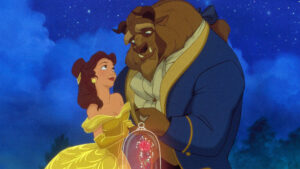
The Princess: Belle is a very complex character, because, while she’s undeniably more feminist than any Princess before her, she’s also trapped in a situation that is, without a doubt, not. There’s a lot of misconceptions about her character: some people want to believe she’s a victim of Stockholm Syndrome (i.e., a prisoner who begins to take on the characteristics of, and eventually falls in love with, their captor), and they’re not necessarily wrong for thinking that – but they should also take into account that Belle retains her individuality throughout the movie and is acutely aware of the fact that she’s a prisoner. At the same time, she does fall in love with a monster who repeatedly invades her privacy (he literally has a magic mirror that can see her anywhere she goes – ewww), violently threatens and intimidates her, and also locks her father in a cold dungeon. Even when he saves her life, it’s not immediately clear whether it’s because he cares for her, or because he’s just obsessively protective. On her own, Belle is a strong-willed, intelligent young woman with a passion for reading, educating herself, and understanding the world beyond her small-scale provincial life. It’s only when she interacts with the Beast that problems start to arise. Rating: 6/10
The Prince: the Beast is far from Disney’s most appealing character: he’s a selfish, self-absorbed brute who gets wildly aggressive at the slightest provocation and flies into a rage when Belle does…anything. A monstrous being covered in fur who happens to walk on all fours at certain points in the movie, the Beast is basically more akin to a large angry dog than an actual person. Belle falls in love with this large angry dog (raising questions I dare not try to answer), and eventually he warms up to her – most people claim that the moment he “changed” was when he rescued Belle from the wolves as she tried to flee from his castle: but considering that the previous scene had him yelling at her to get lost, I would honestly say that he only began to change as a person later on, when he woke to find Belle by his side, healing his wounds. Which means that his initial “rescue” attempt was actually just him going through another violent mood-swing and deciding he didn’t want her to leave after all. And that sort of thing makes him a villain in my book. Rating: 4/10
The Villain: the real villain of the piece, in a movie where everybody is a little more morally gray than your typical Disney Princess film, is Gaston: the hyper-masculine thug intent on marrying Belle and converting her to his outdated, backwards-thinking ideology about woman’s place in the world. Gaston usually ranks pretty low on most peoples’ lists of great Disney villains because of how evil he is – that steadfast, hateful evil is precisely what makes him so effective. In a movie that lauds itself as the first feminist Disney movie, the villain pretty much has to be toxic masculinity (fun fact, Gaston was Disney’s first male villain in a Princess film). Rating: 4/10
The Songs: nearly one of Disney’s best musical repertoires, the Beauty & The Beast soundtrack is only marred by the inclusion of Gaston’s egoistic ballad to himself (a song that demands to be fast-forwarded through). “A Tale As Old As Time”, which rightfully won an Academy Award, is a stirring, beautiful piece of music which excellently compliments the incredible visuals of the Beast’s CGI ballroom – Celine Dion’s incredible vocals were far better suited to a song of that epic quality than to the wistful lullaby she recorded for the 2017 remake of the animated classic: “How Does A Moment Last Forever”. Rating: 8/10
Happy Ever After? a complicated film, to say the least. Belle’s character is adventurous, smart, introspective and empathetic – a great role model, right? But what about what her character’s romance with the Beast says about real-life relationships? Is it acceptable to stay with a violent, uncaring man who locks you in your room and forbids contact with the outside world? Um, no. We all want to praise Belle for choosing to become the Beast’s prisoner in her father’s stead, but we can’t do that without also condemning the Beast for his downright evil actions – and to do that, we have to rethink their romance, which leads to a lot more confusion. This is one of Disney’s messiest movies, and I don’t know whether the tale as old as time should go down in history as a feminist parable – or an uncomfortable metaphor for abusive relationships.
Aladdin (1992):
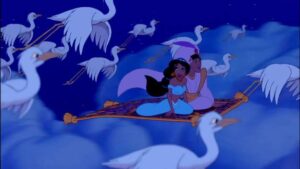
The Princess: Jasmine is the only official Disney Princess to not be the star of her movie – but if anybody deserved to be, it’s her. Outspoken yet inconsequential, Jasmine is constantly on the verge of having something to say: she always wants to do something big and bold, she also goes right up to the edge, she’s about to take the plunge – and then the male characters come in and interrupt her moment. It’s one of the reasons why it was so liberating to finally see Jasmine let loose in this year’s Aladdin remake, which saw the princess come into her own, at least a little, with a defiant song of her own. But even in the original film, while she had little to do, she still made the most out of every minute: though I’m a little confused as to how her sheltered palace life trained her to be a superior pole-vaulter (a talent she only got to display once, sadly). Rating: 7/10
The Prince: roguish, charming and charismatic, Aladdin is the precursor to Disney’s perfect Prince, Flynn Rider (who’s still almost two decades away, so keep waiting). Yes, so he lies to Jasmine about who he is and all that – but everybody in Aladdin lies about something at some point: that’s the nature of the story. It’s all about intrigue, deception, and how things aren’t always what they seem: but Aladdin, who seems to be nothing more than a no-good street rat, turns out to have a heart of gold…and for that I couldn’t be more thankful. In my opinion, he’s Disney’s first truly lovable Prince. Rating: 8/10
The Villain: a lot of people really love Jafar. I can’t say I’m one of them. The tall, gaunt vizier certainly looks impressive in his red and black finery, wielding his hypnotic cobra-scepter, but he royally messes up every strategy he devises, and most of his plans simply don’t make any sense: for instance, he had the Sultan of Agrabah under his control for the entire movie – and yet he wasted one of his three wishes making himself Sultan of Agrabah. Why bother? And at the end of the film, the power-hungry Jafar uses his final wish to become a Genie – at which point he gets trapped in his very own lamp and flung into the desert. Rating: 5/10
The Songs: most of the songs in the original Aladdin are good because of Robin Williams’ incredible voice-acting and improvisational method. That being said, nobody does “Arabian Nights” better than Will Smith in the 2019 remake. Similarly, “A Whole New World” was elevated by Mena Massoud and Naomi Scott in the remake to whole new heights – the original is okay, but a bit shrill for my taste. And Scott’s “Speechless” has become so iconic already that it’s almost too weird for words revisiting the original animated feature and remembering that the song wasn’t in it. Rating: 7/10
Happy Ever After? it may not be the best of Disney’s animated offerings, but Aladdin has a lot going for it – an intelligent princess who speaks her mind (or at least tries to); a prince who set the groundwork for an even better one to come; and a bunch of great songs. It’s got problems, of course: “slave Jasmine” reads as a desperate attempt to exoticize the Middle Eastern princess, and there are a handful of questionable lyrics that had to be revised when the film was remade this year. But for the most part, it’s a fun, charmingly comedic movie with a lot of heart, and irresistibly wonderful performances.
Pocahontas (1995):
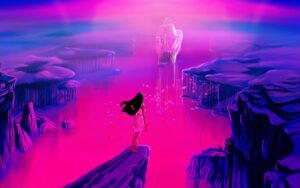
The Princess: everything that Pocahontas does, she does for her people and the betterment of her society: a brave young woman looking for purpose and direction in an increasingly violent world, Pocahontas’s journey is extremely significant in her own era – both as an inspiration (she is, in my opinion, Disney’s first truly feminist heroine), and as a cautionary tale about the dangers of rewriting history. Unfortunately, the real-life Pocahontas wasn’t quite the spirited leader that the films paints her to be – in reality, she was a child kidnapped from her tribe and abused, forced into marriage, converted to Christianity and paraded around England as a “noble savage”. So while it’s perfectly fine to feel empowered by the Disney Pocahontas’ story, it also doesn’t hurt to learn about the real Pocahontas’ tragic life, and the violent history of European settlers in North America that Disney chose to bypass of even ignore in the film. Rating: 8/10
The Prince: John Smith is hard to like, largely because anyone aware of the historical narrative behind the film will know that the real-life Smith was anything but the blond-haired, blue-eyed “man’s man” that the film chooses to make him – Smith was, in actuality, far older than Pocahontas, and was just as nasty as the Disney film’s villain, Governor Ratcliffe. The opening of the film tries to show some of that, by having Smith laughing about how he’s going to kill a bunch of “savages” in the New World, but then attempts to redeem him by having him fall in love with the heroine and go on a psychedelic journey through an animated wilderness during the “Colors Of The Wind” sequence – yeah, last time I checked, all the beautiful animation in the world still isn’t enough time to turn racist colonizers into decent people. Rating: 3/10
The Villain: historical accounts vary, but one thing is clear: the real Governor John Ratcliffe was nothing like the greedy, vainglorious buffoon that Pocahontas and her allies face down in Disney’s reinterpretation of the story. The real Ratcliffe traded peacefully with the Native Americans he encountered, until his abrupt death at their hands: in an ambush supposedly laid by the Powhatan tribe, Ratcliffe was captured and burned at the stake. In the Disney movie, Ratcliffe is instead exposed for the fraudulent idiot that he is and sent home to England in chains. A perfect ending for a perfectly despicable villain. Rating: 6/10
The Songs: I have no idea whether this is an unpopular opinion, but Pocahontas has the best songs of any Disney movie. “Steady As The Beating Drum”? Beautiful. “Just Around The Riverbend”? Emotional. “Listen With Your Heart”? Magical. “Colors Of The Wind”? Inspiring. “Savages”? Terrifying. “If I Never Knew You”? Quite possibly the most romantic song from any Disney movie ever – and it only showed up in the end-credits! Rating: 9/10
Happy Ever After? the story of Pocahontas was horribly butchered to work in the family-friendly Disney narrative, and it’s no wonder that a lot of people try to forget about it, or pretend it never existed (have you noticed that it’s, like, the only Disney classic not getting a remake? Yeah, there’s a reason for that). It’s a shame, because Disney could have chosen any number of actual Native American folktales and legends to adapt that would not have involved the brutality and atrocities committed by white men in the Americas. A character like Disney’s Pocahontas, in a more historically accurate and responsible movie, could have been a revelation. But instead this is one movie that most people will always condemn for its undisputed dishonesty.
Mulan (1998):
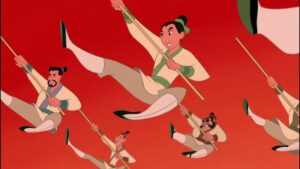
The Princess: it’s no secret that Mulan is my favorite Disney Animation film of all time, and in no small part because of Mulan herself: brilliantly voiced by Ming-Na Wen and brought to life with incredible humanity, the character is an icon. A selfless, introverted woman who decides to takes her father’s place during war-time by disguising herself as a man and joining the army, Mulan ends up becoming China’s greatest warrior, defeating the invading Hun army not once, but twice, and winning the respect of her family and country. She’s the only Disney Princess who’s not technically a Princess – but she was given the title because her bravery and acts of courage were just that awe-inspiring. She’s consistently ranked near the top (or at the top) of Most Feminist Disney Princess lists. And did I mention she saved all of China? Rating: 10/10
The Prince: not only was Mulan not a Princess, but her love interest, Captain Shang, was most assuredly not a Prince. A practical, cynical, solemn guy who has the honor of being Disney’s first Prince to go fully shirtless, Shang established a close relationship with Mulan before he even knew she was a woman in disguise: so close, in fact, that some believe Shang was subtly coded as bisexual. And when Shang does find out, well…okay, well, first he sulks, and gets really angry about it, and he storms off like the drama queen he is – but then, when Mulan comes back to tell him that the Huns have invaded the capital, he finally loosens up, sees the error of his ways, and helps her defeat Shan Yu. Rating: 7/10
The Villain: speaking of Shan Yu, he is absolutely the weakest part of this incredible movie. I don’t know if Mulan (which is, all things considered, Disney’s most mature Princess film) could have sustained a more over-the-top, comical villain like an Ursula or a Hades, but it could probably have used something a bit more exciting than this creepy killing-machine. Shan Yu gets down to business in the very first scene of the movie, and doesn’t relent until he gets blown to pieces by fireworks in the finale: he doesn’t take any joy in his evil (though he smirks so much you might get the wrong impression), and he’s not got a charismatic bone in his gigantic body, but he’s definitely terrifying. And in the tradition of Disney villains having bird sidekicks, Shan Yu has a particularly menacing hawk that follows him around – before getting deep-fried in one of the most lovely bits of comeuppance I’ve ever seen. Rating: 5/10
The Songs: yet another virtually perfect soundtrack from Disney. If I had to point out one problem, it’s that the reprise of “I’ll Make A Man Out Of You” at the end of the film is far too brief, and that the version of “Reflection” used in the movie itself doesn’t quite match the splendor of the end-credits version performed by Christina Aguilera. Rating: 8/10
Happy Ever After? this is my favorite Disney movie for so many reasons. Action, adventure, comedy, drama, feminism, romance, you name it – Mulan‘s got it. And it marks a huge progression in the way that Disney portrayed (and continues to portray) female characters: Mulan was the first Disney Princess to bear arms, and unsurprisingly she also has the highest kill count of any Disney Princess (her record is 1,995, in case you’re wondering). The Emperor even offered her a place in his council (which she politely refused). And while she and Shang clearly had feelings for each other, their relationship still had a long way to go by the end of the movie, marking a nice change from other Disney films in which heroines meet, fall in love with, and marry their love interests in less than a week (ahem, Ariel). Considering that the film was originally conceived as the story of a starving Chinese orphan girl who is saved from her miserable life by a British gentleman and goes off to live with him in the West, I’d say that’s progress.
The Princess And The Frog (2009):
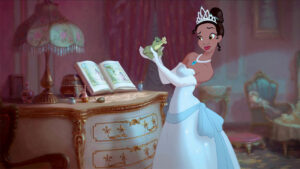
The Princess: Tiana gets overlooked and underrated a lot. Disney’s first African-American Princess, and the first Princess to hold a job, this idealistic, hard-working modern (a.k.a. 1920’s modern) woman was a refreshingly unique addition to the royal Disney line-up. Unfortunately, due to plot circumstances, she spent almost the entirety of her movie in the body of a frog, meaning that there was very little time to actually learn to appreciate her as a person. Like Pocahontas before her, Tiana is an awesome Princess trapped in a so-so movie: in a better one, where she could have been happily human, I think she might have connected with audiences far more than she did. Rating: 8/10
The Prince: Prince Naveen, the distinguished (but nearly bankrupt) royal visitor to New Orleans who gets turned into a frog and accidentally drags Tiana into his chaotic troubles, could have made for a fairly interesting love interest – but the movie never really does anything with him. We never even get to learn what culture he’s supposed to come from, or what his motivations are – beyond making (or rather, being given) large amounts of money. He’s the pampered, materialistic royal brat that Princess Jasmine was originally written to be – but there’s a reason the makers of Aladdin changed Jasmine’s characterization, and somebody should have thought to do the same with Naveen. Rating: 4/10
The Villain: the New Orleans sorcerer charlatan Doctor Facilier has all the elements of a great, even iconic rogue – his bright, flashy sense of style; his deep, charismatic voice (provided by Keith David); and his unique brand of magic, informed by voodoo and occultism. In his secret lair/otherworldly portal/music hall, the top-hatted Doctor plots devious ways to scam the gullible out of their money, while his autonomous shadow capers about the shadows with gleeful sinuosity. Unfortunately, the movie doesn’t use him to the full extent, and as a result he too is frequently forgotten. Rating: 5/10
The Songs: with a soundtrack inspired by the awesome sounds of Jazz Age New Orleans, you would think The Princess And The Frog would have some of the most memorable songs in Disney history. But as with everything in this movie, it’s a great concept that doesn’t really amount to anything in the actual film. There’s a couple of tunes you can hum along with – “Almost There”, “Friends On The Other Side” – but that’s my limit. Rating: 4/10
Happy Ever After? according to Disney executives, putting the word “Princess” in the title of this movie was their fatal mistake, as it supposedly alienated audiences who felt it was more childish than other Disney offerings. But in my opinion, the studio should have worried less about the title and more about making a good movie. The Princess And The Frog has a whole bunch of cool, even unique ideas, but they’re buried under a boringly conventional comedy: you want two interesting protagonists who are both people of color? Okay, but, surprise, they’re frogs. You want a thought-provoking exploration of class and racial divides in a historical setting? Okay, but only about a half-hour of the movie is actually set in New Orleans – the rest of the time you’ll spend in the fantastical bayous of Louisiana with a musical alligator and a romantic firefly. This movie could have been excellent, but there’s simply too many stories and subplots going on all at once.
Tangled (2010):
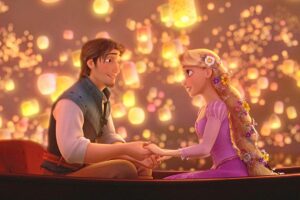
The Princess: Rapunzel is everything that Ariel should have been twenty years earlier: she’s just as naive and occasionally nonsensical as her aquatic predecessor, but always retains her wits and sense of responsibility – unlike Ariel, Rapunzel looks before she leaps (quite literally) from her cloistered tower. Her journey is also one of Disney’s strongest arcs in recent history: a princess whose incredibly long hair inherited the healing properties of a magical flower, Rapunzel was abducted at birth by Mother Gothel (more on her in a minute), who raised her as a daughter for sixteen years, using her to extend her own life and keep her healthy and youthful. But once Rapunzel realizes what’s going on, she wastes no time in standing up to her abusive parent and fighting for her rights. Rating: 9/10
The Prince: Flynn Rider is Disney’s best Prince: classically charming, roguish, casual, funny, practical, handsome…it’s almost like he was designed by a focus group of real women who were asked to design the most attractive man in Disney history. Oh wait, he was. The culmination of decades worth of experimentation and slow progress, Rider is the perfect counterpart to Rapunzel’s innocence – a cunning outlaw who initially underestimates the princess, but eventually finds himself falling in love with her. Rating: 9/10
The Villain: Mother Gothel, Rapunzel’s abusive mother figure, has her pros and cons – on the one hand, she’s very much a revamp of the Wicked Queen and Wicked Stepmother of earlier Disney films, and her motivations (everlasting beauty and longevity) are uninspired; but on the other, her character is far more interesting – and real – than almost any Disney villain before her. Gothel is purely evil, manipulating Rapunzel and constantly undermining or mocking her: in her chilling song, “Mother Knows Best”, the hateful villain derides her daughter for even daring to think she could survive in the outside world. But trapped in Gothel’s tower, Rapunzel is subjected to constant humiliation on multiple levels – for instance, Gothel’s affections are rarely lavished on Rapunzel herself, but rather on her magic hair, the only part of her that Gothel actually cares about; Gothel even refers to her as “Flower”, reducing her to nothing more than an inanimate object to be used for her powers. What’s even more terrifying is the realization that, if Flynn Rider had never shown up and upset the natural balance of things, Rapunzel would have been forced to spend her entire life serving the needs of this horrible, semi-demonic creature. Yikes. Rating: 8/10
The Songs: None of the songs in Tangled are real showstoppers – there’s the aforementioned “Mother Knows Best”, which I think is the best song in the movie, and there’s “I See The Light”, which is formulaic at best, and beyond that…well, there is “When Will My Life Begin”, which does have a catchy tune. I mentioned a while ago in this post that all the Disney Princess films since Sleeping Beauty have had at least one great song? Tangled is the only slight exception to that rule. Rating: 4/10
Happy Ever After? this film has had one of the longest journeys to the big screen in all of movie history – initially, Walt Disney himself planned to adapt the classic fairytale, but couldn’t figure out a way to make the story suitably epic (apparently, Snow White was epic enough for him), and he shelved the project. Decades later, in the early 2000’s, the studio began working on a Rapunzel movie that would have been witty, funny and a little cheesy. Then it became a modern fairytale set in San Francisco. Finally, after much deliberation and years of hard work, it became the studio’s fiftieth animated picture, and opened the door to the new world of Disney CGI films. Along the way, they created one of their most charming, heartwarming stories yet: an empowering, distinctly modern fairytale that would probably have Walt Disney spinning in his grave. It’s a great indicator of how far Disney (and society) has come, and of how far they still have to go.
Brave (2012):
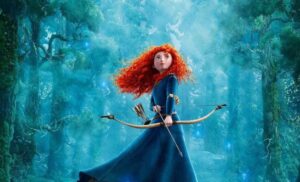
The Princess: Merida absolutely should have been awesome. She’s a feminist warrior princess with irreverent Gaelic sensibilities, who wields a gigantic longbow, communicates with the magical spirits of her highland forest like Scottish Pocahontas, and refuses to get married despite her mother’s insistence that she act like a proper Medieval lady and marry another nobleman to unite the clans. Merida realizes that she doesn’t need to get married to do that: instead, she brings unity to her land through sheer presence and force of will. And all those things help to make her one of Disney’s coolest Princesses – on paper. In the actual film, while Merida displays incredible bravery, she never gets to fully unleash that inner Boudicea that I think we all wanted to see – as a warrior, she doesn’t even come close to rivaling Mulan’s kill-count. And as someone of Celtic descent myself, I expect to see my Celtic princess go full berserker. One measly fight with a demon bear? That’s the best that Disney/Pixar could muster? Rating: 7/10
The Prince: Merida is the first Disney Princess to remain single – but she doesn’t just turn down her hordes of suitors. Instead, when she learns that her mother has set up a competition where the firstborn sons of other clan leaders have to succeed at an archery contest in order to win her hand in marriage, Merida, as the firstborn daughter of the King, marches out onto the field and demands to compete for her own hand – and don’t let it be thought that her bark is worse than her bite, because Merida totally owns the competition, splitting another contestant’s arrow-shaft right down the middle in an incredible feat, and scoring a perfect bulls-eye. I’d like to see either of the Charmings try something like that.
The Villain: the primary antagonist of Brave is a giant demon bear named Mor’du, who is revealed to have been the King who originally split up the four clans in an age long past. But by the time our story begins, Mor’du is just kind of wandering around the woods, randomly attacking people or lurking in a super-creepy ruined castle. While there are some truly disturbing flashbacks sequences in which we glimpse Mor’du’s transformation into a giant demon bear, he’s not a particularly interesting villain in an already conventional movie. Rating: 2/10
The Songs: because this is a Disney film, there are songs in Brave. Because this is a Pixar film, those songs aren’t actually sung by the characters in the film – which makes them subsequently feel more removed from the story, less integral to character development and more like pretty embellishments. So no, the music of Brave isn’t anything too fantastic, but I’ve got to give it a few extra points because…well, it’s Celtic. I’m sorry, but anything even vaguely Tolkienesque makes me happy. I’m tempted to give the film far more credit than it deserves simply because one of the art manager’s first name is Lorien. Rating: 5/10
Happy Ever After? Brave might be an unambitious and downright archetypal fairytale at times, but it’s got a lot of heart, and a great emotional core in the story of a young woman’s complicated relationship with her mother; a story that most people will be able to relate to in some way, even if not all of us have accidentally transformed our mothers and siblings into bears. I certainly haven’t. Merida is cool, if underused. Celtic anything is fun, at least in my mind. The humor is typical of Pixar’s more mature, edgy brand. It’s a good movie: it just doesn’t bring anything really groundbreaking to the table.
Moana (2016):
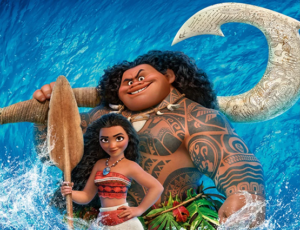
The Princess: she arrived in theaters mere weeks after the shocking 2016 election, ushering in what many believed to be a new, proudly feminist era of Disney movies. This young Polynesian explorer, with her realistic body standard and irrepressible courage, was bound to be embraced with open arms. Decades worth of Disney history are written into Moana’s character, like her very own set of magical tattoos: the fearlessness of Mulan; the stubbornness of Merida; Jasmine’s defiance; Ariel’s curiosity. She’s not Disney’s most unique Princess, but she has the benefit of being the latest in a long line of heroines who have slowly been breaking the glass ceiling since 1950 (sorry, Snow White, you did nothing). Rating: 8/10
The Prince: as in Brave, there isn’t one. Moana spends the entirety of the movie happily single, and shows no interest in romance – nor do her parents or community try to force her into marriage; a refreshing change. Maui, the mischievous demigod who helps Moana on her journey, is sometimes unofficially referred to as the film’s Prince. I prefer to think of Moana as only the second Disney Prince-less movie. And yes, that’s a stupid pun, and no, I don’t care, because Moana features some of the worst humor in Disney history: I think I’m justified.
The Villain: not including a major element of the Disney Princess formula in your Disney Princess movie is a risky move, but it can be done. But that’s not to say it should be done in excess. The big reveal at the end of Moana is that there is no real villain – the volcanic goddess Te Kā turns out to be the life-giving goddess Te Fiti after all: Moana returns the magical Heart of Te Fiti to the deity, and all of Polynesia is saved. It’s a shocking easy ending, and one that instantly makes you think there must be something else coming: but no. Throughout the film, there are minor antagonists (sea monsters, demon pirates shaped like coconuts, a giant crab), but nobody that actually equates to a full-out villain. And without that crucial element, the entire movie ends up falling a little flat. Yes, it’s original – but it’s also somewhat uninteresting when we’ve spent an entire movie watching Moana summon the incredible powers of the Pacific Ocean…only to never have her use them except to part the waves.
The Songs: at the very least, the film has a pretty catchy soundtrack. “How Far I’ll Go”, despite often being unfavorably compared to Frozen’s “Let It Go”, is one of my favorite Disney tunes it’s powerful, inspiring, beautifully performed by Auli’i Cravalho, and it’s accompanied by a great sequence of Moana diving into the ocean and retrieving the Heart of Te Fiti, before rising out of the waters to find the ghosts of her ancestors assembled in a veritable armada, flanking her as she steers her ship into the future. Gets me every time. The downside is that this soundtrack also includes “Shiny”, which ranks somewhere between 0 and -1 on my ranking of Disney songs. Rating: 5/10
Happy Ever After? I’m not a big fan of Moana, personally. It’s got its moments, but the majority of the film is basically just Moana and Maui sailing. While there’s complexity in Moana’s own emotional arc, the plot is just a straight line between Motu Nui and the island of Te Fiti – there are pitfalls and a couple of detours, but nothing that lasts more than a couple of minutes. Watching the film is rather like being on a very slow-moving boat: after a while, the beautiful scenery is really just more water, and the destination is just a hazy question-mark on the horizon.
So there you have it. Every official Disney Princess movie ever – from chirpy Snow White wandering around the forest looking for houses to clean, to fearless Moana daring the open ocean to bring peace back to her village. Do you see the difference? Since 1937, the idea of what defines a Princess has been evolving – slowly, at times, but always just enough that with each new Disney movie there comes just a little bit more progress. We no longer idolize Princesses whose only defining trait was “good housewife” – now, we have warriors, leaders, explorers and businesswomen. With each new movie (except Frozen for whatever reason), the Princesses get stronger, more diverse, and more representative of the personalities, characteristics and motivations of real women and girls across the world.
Who is your favorite Disney Princess, and why? Share your own thoughts and opinions in the comments below!
